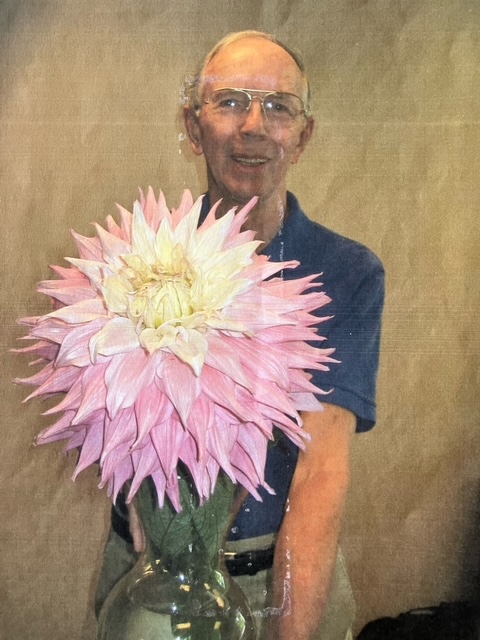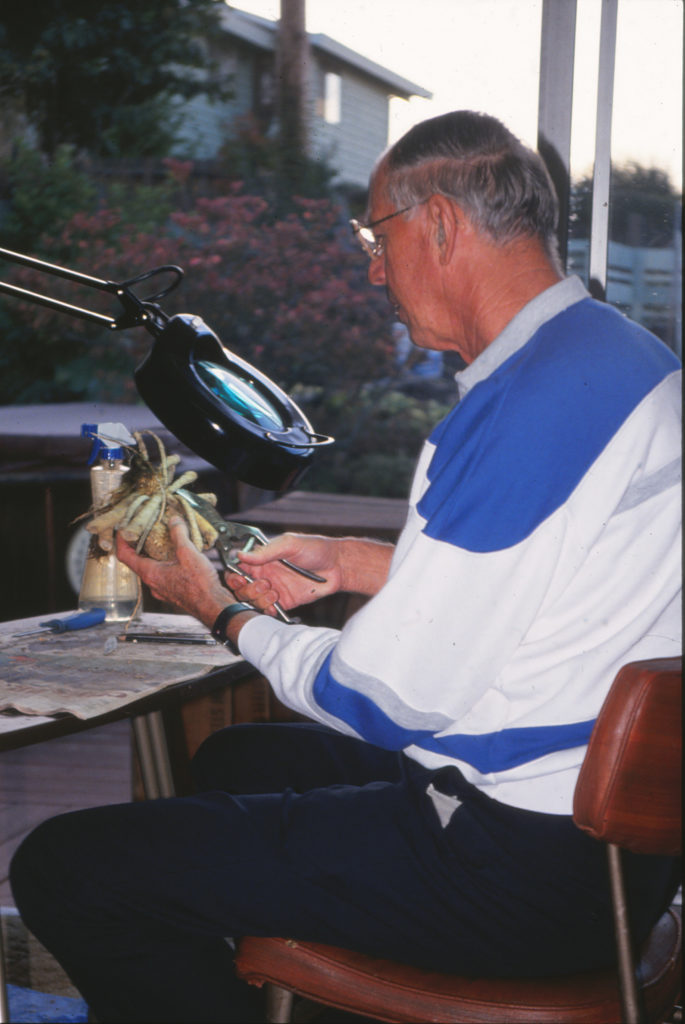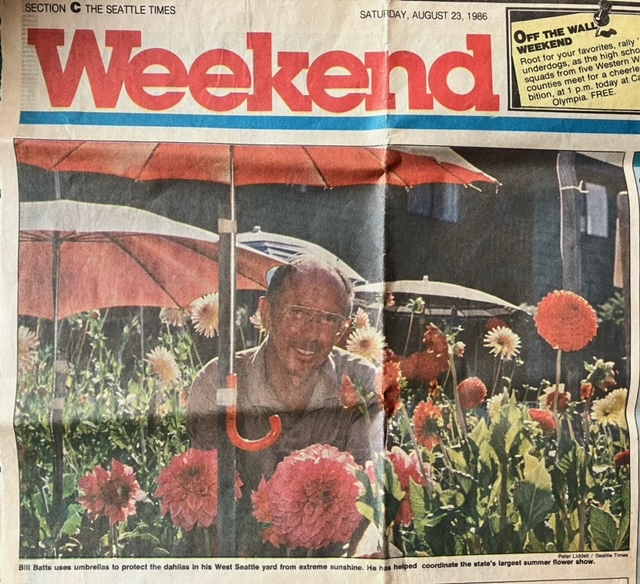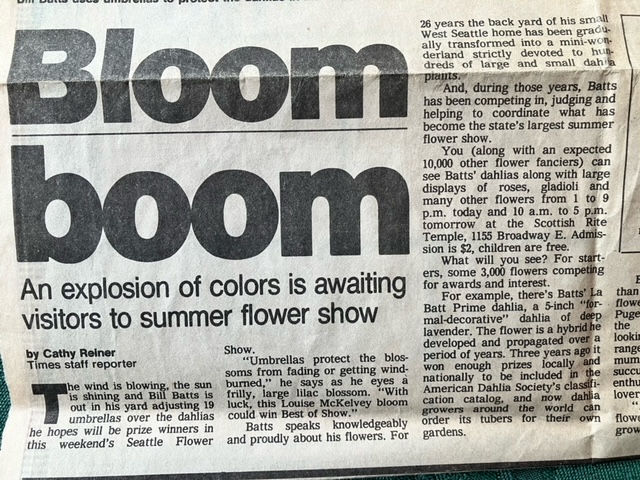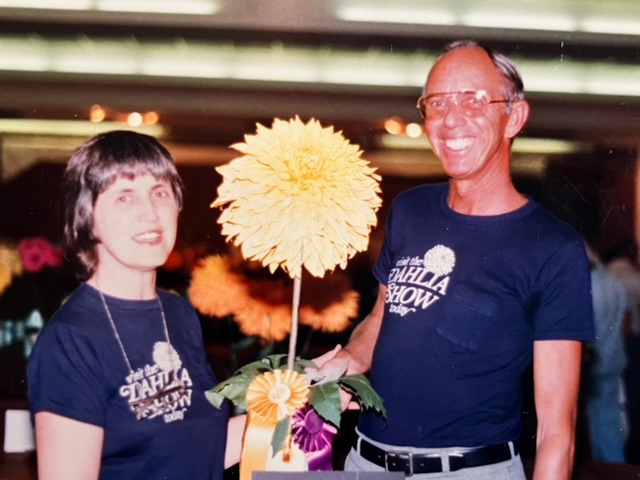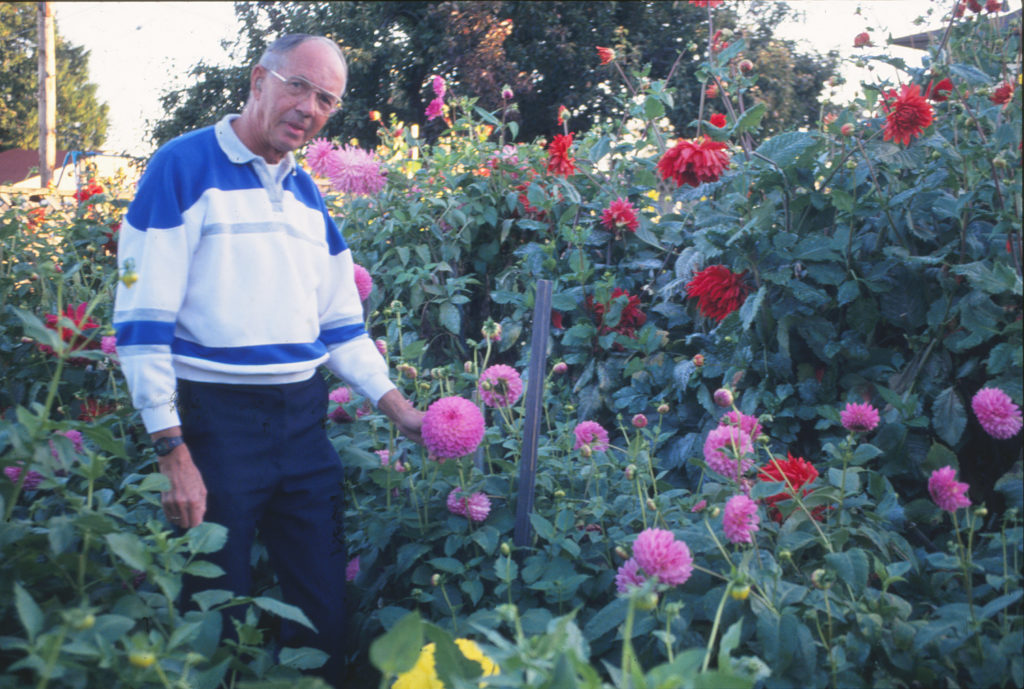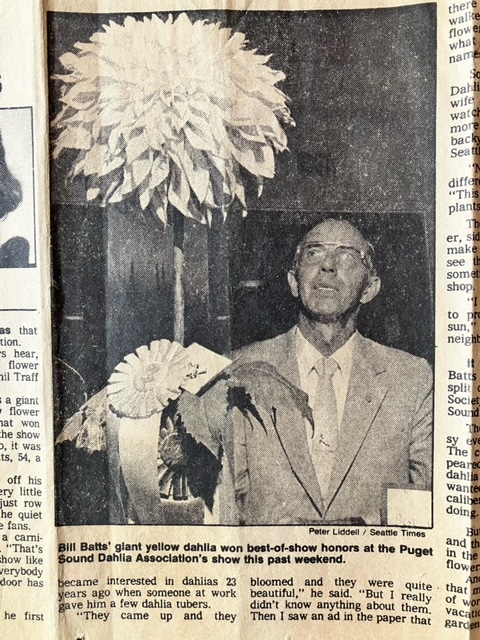Dahlia Legacy Profile
Bill Batts’ Big Beauties
Bill Batts grew them big, bold and beautiful for over six decades.
“I liked something that was worthwhile putting in a vase,” he said, when asked why he gravitated towards the larger dahlias. And, Batts’ dahlias did need large vases.
There is a classic photo of Batts in a 1995 issue of Dahlias of Today which shows him with a row of blood-red Creve Coeur dahlias towering over his tall frame and showing off their 18-inch behemoths blooms, a growing feat that earned him Best in Show that year at the 1994 Seattle Flower Show sponsored by Puget Sound Dahlia Association (PSDA).
Batts was an avid competitor at shows, senior American Dahlia Society (ADS) judge for 20 years, and active club member who always brought the best to shows. “He was the consummate showman,” said fellow grower and long-time friend Roger Walker. “He never brought entries that were less than they should be; his entries were top quality.”
Before he retired from growing, Batts was renowned for his award-winning AA (more than 10-inch), A (8-10 inch) and B (6 to up to 8 inch) dahlias at shows. Newspaper articles covering his career in showing and growing dahlias picture him with huge blooms. Some favorites that he grew in his backyard garden were: Edna C., Creve Coeur, April Dawn, Jennie, Bonaventure, Kenora Fireball, Skipley Spot, Camano Cloud, Frontispiece, Salmon Rays, and Hamari Girl.
Batts is also known for introducing two new hybridized varieties. The first one was Rusty Harpoon, an orange A sized semi-cactus, which debuted in 1980. It was named after a restaurant on Maui in Whalers Village. The second, LeBatts Prime, was introduced in 1985. It is a BB-sized (4 to 6-inch) formal decorative bloom of lavender or pink over white and it enjoys a large online presence in New Zealand and Australia.
He grew dahlias for 63 years; from 1958 to 2021 and until the age of 94. He stopped due to macular degeneration, which impeded his eye-sight to the extent he could no longer tend, dig, divide and label his prized dahlias. During his career in growing and showing dahlias, Batts estimates that he has taken home more than 2,000 show ribbons that at one time circled his home’s rec room several times plus enough trophies to fill a book case.
The Early YearsBatts was born in Seattle, Washington in 1927, growing up in West Seattle near Alki Beach. He graduated from West Seattle High School, going onto the University of Washington, where he received his bachelor’s degree in economics and business, with an emphasis on transportation, in 1951.As Martin Kral writes in Dahlias of Today: “He continued his education by going to night school which culminated in an ICC Practitioners license that allowed him to interpret interstate commerce regulations, such as freight rate increases. He began working at the huge Sears store on South Lander (now part of Seattle’s SODO neighborhood) in the traffic department. Apart from a stint as a United Good Neighbor’s “loaned executive” in 1956-57, Bill and Sears remained working partners until his retirement at age 57.”The year 1956 was also the year he met the love of his life, Lois (nee Wallen). She was the youngest of six children and her family moved to the Key Peninsula of Washington State in the early 1940s. As a young woman, she worked as a switchboard operator, long-distance operator, and attended some classes at the University of Washington. In the fall of 1956, friends arranged for Lois and Batts to meet at a square dancing event. The following year, on February 22, 1957, just one day before her 27th birthday, Lois married Batts, joking she aged a year over-night. They bought a house and settled down in the Genesee Hill area of West Seattle where they raised their three children: Ben, Bill, and Janis. While his children did not follow his passion into the show arena, son Bill did grow some dahlias. In 1997, the couple sold their house and then moved into The Kenney independent-living apartments, settling on the fourth floor apartment overlooking beautiful gardens and lawns. Batts continued growing dahlias at The Kenney until 2021 when his eye-sight failed. In early 2019, they moved to assisted living in the complex and eventually Lois’s Alzheimer worsened and she was moved to The Kenney’s memory care area. Bill remained in assisted living and it was the first time since 1957 they had been separated. Yet, they were remained devoted to one another and not even COVID could halt their daily visits although it was through a window. Their story of staying connected was featured in a Seattle Times November issue of The Pacific NW. Fortunately, restrictions were loosened some and they could see each other again in person. Lois passed away in 2022 a month prior to her 92nd birthday. Dahlia fever takes rootSears was also responsible for Batts interest in dahlias. After moving into the Genesee Hill home, his boss gave him some roots wrapped in old newspaper. According to Kral’s article: “I didn’t know what they were – neither did he. They were wrapped in newspaper and simply marked by color. You know – white decorative, pink, yellow…” Once his first dahlias were growing, he saw an ad in the newspaper for an annual dahlia show and decided to attend. He met people who talked with him about the Seattle Dahlia Society (SDS). He began attending meetings. He met mentors such as Henry Newbom, Phil Traff and Bill Owens, who provided him with encouragement and the knowledge of how to grow and exhibit dahlias. He remained a SDS member for the next 18 years, participating in shows all the way down to Portland, Oregon and serving as vice-president. At the same time, he studied to become an American Dahlia Society accredited judge. In 1974, he held the position of senior judge and was known to help train others. He took his credentials seriously and was known to examine every entry submitted to a show to ensure that it was accurately placed. Batts quit the SDS in 1976 to help form the Puget Sound Dahlia Association (PSDA). “He was a founding member, “recalls Walker. He again took on the role of vice-president for a number of years and also served on the executive board and chaired the annual tuber sale which brought in 60 percent of the club’s annual revenue. (While with the PSDA, he took on the duty of organizing judges for a national show held in Seattle.) Batts and Lois were awarded honorary memberships in 1993, freeing them of club dues and upcoming new assignments.Wife Lois never got into showing. As Kral’s article said: “Bill cuts a solitary, tall figure in this garden, but that is by choice. His wife, Lois, is given control of the house, but when it comes to dahlias she defers to her husband. Perhaps it had something to do with Bill wanting to be fully responsible for any or all awards (or failures). It is also possible that Bill feared that he would be eclipsed by his wife on the show bench. “The only time Lois showed, she grew Salmon Rays for a Novice entry in the National Show in Spokane. She won the trophy for the best BB in the show, but my Rays didn’t score as highly,” Bill chortled. ”And that’s why Bill won’t let me into the garden any longer,” his wife chimes in.” Batts and wife Lois did work together on tuber sales. Batts stored more than 30,000 roots that were dug from Phil Traff’s nursery at Orting. The couple also spent hours counting, dividing, and tagging tubers for the club’s tuber sale to the public but also to supply local nurseries and garden centers. It was a major job as the nurseries and garden centers were monitored for supply and at the end of the selling season the unsold packages reclaimed so billing could be done. Retail outlets that participated included: Sky Nursery, the West Seattle Junction Feed and Seed store, Sears, Pike Place Market and others.Growing the Big Beauties Batts built up his stock over the years through tuber sales and by ordering from established commercial growers. He favored growers such as Les Connell and Swan Island. Batts said that growing large, show-quality dahlia blooms is a matter of focusing on the characteristics of the dahlia plants and then propagating the stock of those that genetically have the desired traits. His backyard of glacial till was his first challenge as it had to be augmented with the nutrient biomass that dahlias needed. With annual tilling and supplementing, the area behind his home was turned into a 45 by 50-foot plot where he was able to house 450 plants of 97 varieties. Batts regularly worked in a three-way soil amendment every spring but then later moved to Cedar Grove compost (composted yard waste). “One year I brought in a whole truckload,” he tells. He credits much of his success to producing show-quality blooms to the care given to improving soil. In June, he might augment the nutrient-rich compost with a dose of Rapid Grow, a quick release fertilizer, or some liquid fertilizers mixed in a watering can, but, he said some dahlia varieties just didn’t need any further fertilizing. They just genetically had the ability to grow into large blooms. Batts placed his support stakes two feet apart in rows and plants two tubers per stake. He would water depending upon the weather. If it didn’t rain, watering was done every other day or as needed. Usually, he used watering hoses with a low spraying sprinkler heads and watered only in the early mornings. When asked what his most valuable tool was when working with the dahlias, he said that it was a hoe for keeping the weeds down. He also used a rototiller to churn the soil in the garden before planting.As far as diseases and pests are concerned, he would try to keep late season fungus off of the leaves by ensuring that water was kept off the leaves when possible. He fought earwigs, spider mites, and slugs. The slugs would get in and eat the sprouting plants before they could grow. But, he used insect sprays and slug bait judiciously. He also never had an issue with gall, or saw it appear on his tubers. When buying or planting a tuber, Batts recommends looking for tubers that are firm and not spongy. The size doesn’t seem to make a lot of difference. But, also look for a good eye, indicating the tuber is viable. According to Kral’s article, here’s how Batts prepared his own tubers for storage. “To get his own roots ready for storage, Bill brings the washed uncut roots into the plastic-covered rec room. He then uses a magnifier lamp to better identify the eyes. Dividing is done with bonsai shears and a rusting pair of True Friends secateurs. After tubers have been separated, Bill mists them with a bleach mixture of 1 cup Purex to 2 gallons of water. For someone who used to be famous for his root storage technique, you’d think that he would advocate waxing to growers desiring a good turgid tuber. Maybe after seeing all different roots come from the donors who employed diverse storage approaches, Bill has decided that there is just not one good method. He concedes that while wax-covered roots “are the prettiest,” waxing proved too time-consuming. Maintaining the proper temperature in the water-wax mixture is another challenge. These days, Bill recommends dry cedar shavings or vermiculite and store his roots in plastic bags. Wood boxes and paper grocery sacks serve as containers for the root bags.” Tricks of the Trade for Showing WinnersBatts began by competing in the Seattle Dahlia Society shows, and after the Puget Sound Dahlia Association formed, he would enter that show every year.The umbrellas over certain dahlias in his backyard were like a signal flag of which dahlias he deemed good enough to be destined for the show arena. Seattle Times reporter Cathy Reiner visiting Batts on a windy day at his home, found him in the garden adjusting 19 umbrellas over a range of dahlias. “The umbrellas prevent the blossoms from fading or getting wind burn,” he told her, eyeing a large lilac blossom. “With any luck, this Louise McKelvey bloom could win Best of Show.” During the show season as the blooms became ready, Batts and family often participated in one show a week, combining a vacation and travel with the excitement of a show. The shows occurred on a weekend, but preparation started days before as he carefully monitored the blooms progress as they moved toward show time. Batts picked the dahlias on a Friday, put them into buckets of water to store in a cool garage. In the evening, he would decide if they would be single or triple entries, cut the stems down, place the entry tags on them and place them in the square metal containers of crushed Styrofoam to keep the blooms upright. By Friday night, they would all be ready to load up for Saturday morning departure to the show. Sunday would consist of the awards presentations and then removing his displayed blooms and travelling home, and clean-up. “It took about four days,” he said. After the couple sold their home in 1997 and moved to The Kenney in West Seattle, Batts was able to continue growing dahlias at the new residency and remain a familiar face at shows with his exhibits. While at The Kenney, he would prepare the blooms for show as before, but would keep them on the balcony ready to be packed up in the morning. He liked to enter blooms that were B, A, or AA in the single entries mainly, but with some triple entries. Transporting the dahlias to the shows can be a major challenge. Batts took the back seats out of his car, put plywood down on the floor and then loaded milk crates into car. The blooms were staged in square metal vases/containers. He would put four containers per milk box. In order to take more blooms to the shows, as well as transport the family to the shows, he built a container that would travel on top of the car to carry the blooms. It was made out of plywood and painted green, and he would continue to use the same milk crates and square metal containers for the blooms. “I had to be a very careful driver in order to keep the blooms in perfect show condition,” he said.There were many years of enjoying show competitions with some that stood out as special triumphs. At the Puget Sound Dahlia Association show in 1982, he won Best of Show with Bonaventure. In 1995, he won Best of Show at the Evergreen State show in Olympia with Jenny. He also won Best of Show at the Puget Sound Dahlia Association show in Seattle with Camano Cloud. That year he also showed in Montana at the American Dahlia Society’s national show and won the best giant with Irene‘s Pride. In 1996, he won Best of Show at the Grays Harbor competition in Elma with Jessie G.Batts never competed in any shows outside of the United States, but he did attend and exhibit outside Washington in places like Portland, Oregon and Kalispell, Montana. Shows he often attended were: Evergreen State in Olympia, Grays Harbor in Elma, Kitsap County in Bremerton, Inland Empire in Spokane, Snohomish County in Everett, Washington State in Tacoma, and Yakima Valley in Yakima.Tips for New GrowersHis main advice to new growers is to take the time to explore the various types of dahlias available before settling into a type. “Start with an assortment of types of dahlias, and then find what grows well,” he said, adding new growers can then “decide what they like to compete with, and what they enjoy growing.”New growers and show-goers can learn a lot by joining a society or club in their area. The Puget Sound club meets monthly and provides information and support on how to enter and stage exhibits in shows. At the same time, it is a place where new exhibitors can learn about judging and the various categories and colors.Dahlias have held Batts interest for over half a century and he maintains they are a flower that has much to offer in their diverse forms and broad spectrum of colors. “They are beautiful, they can grow to their maximum in one year from seed and also they don’t smell – most have no aromatic pollen, so they are good for people who have allergies.” |
Hall of Fame
Not currently a Hall of Fame Member
Originations
| Cultivar | Size | Form | Color | Color Description | Orig | Cnty | Year |
| LE BATTS PRIME | BB | FD | L | BTT- | US | 85* | |
| RUSTY HARPOON | A | SC | OR | BTT- | US | 80 |
